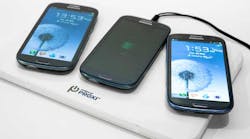The idea for using wireless power transfer to charge batteries has been around for years. While a few smartphones boast wireless charging capability, the technology has been waiting on the threshold of wider adoption. Now, PowerbyProxi and Texas Instruments have announced an agreement that should move it forward.
The lack of a single standard has inhibited widespread use, though three standards organizations are vying for acceptance: the Alliance of Wireless Power (A4WP), the Power Matters Alliance (PMA), and the Wireless Power Consortium (WPC). The IEEE is also involved with its Wireless Power and Charging Systems Working Group (WPCS-WG) and hopes to move toward a single standard if possible.
All of these charging methods are based on inductive coupling. A transmitter driving a primary winding in a charging base creates a magnetic field that induces a voltage into a nearby secondary winding and receiver inside a smartphone, tablet, notebook PC, or other portable electronic device. Most configurations use a flat charging base with one or more transmitter coils, and the device to be charged lies on top (see the figure). The PMA and WPC standards use an ac frequency in the 100-kHz to 200-kHz range while the A4WP uses a more efficient resonant solution on the 6.78-MHz industrial, scientific, and medical (ISM) band frequency.
The technology licensing agreement between PowerbyProxi and TI could mean a shift toward the WPC standard, which is known as Qi (pronounced “chee”). PowerbyProxi is a New Zealand intellectual property (IP) firm with more than a hundred patents in the wireless charging space. TI makes a complete line of Qi transmitter and receiver chips, such as the bq500412 transmitter, which can be used to build charging pads of the 5- or 12-V variety with up to three primary coils and comply with the WPC 1.1 standard.
TI and PowerbyProxi initially will focus on developing and delivering a resonant solution compatible with the WPC Qi standard. PowerbyProxi’s wireless power IP can work across any standard being used and developed globally. With the agreement, TI can add a new, broader range of wireless charging products based on PowerbyProxi IP. Consumers are ready and waiting for these fully integrated wireless charging features on mobile products.
PowerbyProxi
Texas Instruments
